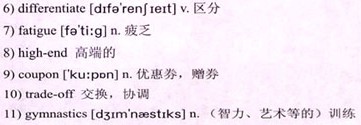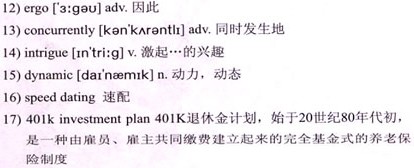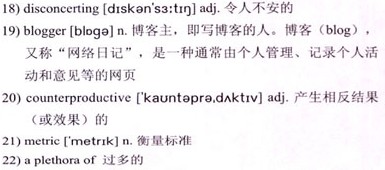Toothpaste, Dating, and Data: the 1)Hazards of Too Much Choice “多选”的烦恼
文字难度:★★★☆
It’s an experience common to most Peace Corps volunteers upon their return to the United States. After having spent a couple of years in remote places where consumer choices were limited at best, they go into a grocery store in the U.S. to buy something and end up standing 2)glassy-eyed in the aisles, paralyzed and overwhelmed by an overload of choice. Faced with an entire aisle full of toothpaste options—one whitening, one brightening, and one with extra3)fluoride and 4)baking soda ingredients—their eyes 5)glaze over and they stare, unable to choose or buy anything.
美国维和部队的大多数志愿者一回到美国后都有这样的经历。在消费选择即便有也不多的偏远地区生活了数年后,当走进美国的一间杂货店购物,他们最后都会目光呆滞地站在一排排货架前,不胜其“繁”而一动不动。面对一整排摆满各种牙膏的货架——增白的、提亮的、含氟和小苏打成分的——他们呆呆地盯着商品,无从挑选或购买。
Even without the Peace Corps background, it’s a consumer experience I can relate to very well. More than once I’ve set out on a shopping mission and realized, after trying on the 12th pair of jeans, shorts, shoes, etc. that I have lost my ability to 6)differentiate or decide. My brain has gone into decision 7)fatigue, and all I want to do—indeed, all I have the ability to do—is go home.  尽管没有参加过维和部队,我却对这种消费经历深有体会。不止一次了,本来目标明确地出去购物,试穿了一打牛仔裤、短裤、鞋子,诸如此类,之后却发现自己已经丧失了辨别和做决定的能力。我的大脑已疲于抉择,唯一想做的——事实上,唯一能做的——就是回家。
尽管没有参加过维和部队,我却对这种消费经历深有体会。不止一次了,本来目标明确地出去购物,试穿了一打牛仔裤、短裤、鞋子,诸如此类,之后却发现自己已经丧失了辨别和做决定的能力。我的大脑已疲于抉择,唯一想做的——事实上,唯一能做的——就是回家。
Apparently, I am not alone. In her recent book The Art of Choosing, Columbia University business professor Sheena Iyengar cites numerous research studies that indicate an inverse relationship between choice and the ability to decide. In the late 1990s, for example, she and colleagues conducted an experiment in a 8)high-end food store in California. On different days, they set up a tasting table of jam, offering each taster a 9)coupon for a dollar off if they bought a jar. On some days, the researchers offered only six types of jam. On others, they offered 24 different options. While the 24-jam display attracted more attention and induced more people to stop and look at the jams, (60 percent of incoming store customers stopped at the larger display, versus 40 percent at the smaller display), the actual sales generated from the displays were quite a lot greater at the smaller display (30 percent of those who stopped, versus three percent with the larger display).
显然,并非独我如此。哥伦比亚大学商学院的教授希娜·艾扬格在她的新书《选择的艺术》中引用了大量的研究,这些研究显示出选择项的多寡与决断力两者之间的逆向关系。以她和同事于20世纪90年代末在加利福尼亚州一家高档食品店里做的一项实验为例:在不同的日子里,他们在店内摆设果酱试吃摊位,向试吃的顾客派发“买一瓶省一美元”的优惠券。有几天,这些研究员只摆出6种果酱;另外几天,他们则提供24种果酱以供选择。尽管24种果酱的推销展台引来了更多的关注,更多人驻足注目(在进入该店的顾客中,有60%的人在大规模的果酱推销点前驻足,而小规模的果酱展台只吸引了店内40%的顾客),然而小规模的果酱展台所带来的实际销售额远大于大规模的果酱推销展台(在小规模的果酱展台前驻足的顾客中有30%的人购买了果酱,而对于大规模的果酱展台而言,其相应数字仅为3%)。
Iyengar presents psychological explanations for why we glaze over at too many choices, including the fact that choice is a complex process that requires that we a) know what we want, b) understand what makes the choices different, and c) can evaluate the 10)trade-offs involved in choice A over choice B. Processing that for six choices is possible. Doing all those mental 11)gymnastics for 24 options is more than our brains can handle. 12)Ergo, we simply walk away. Iyengar says the ideal number of choices most humans can process well is somewhere between five and nine, since that’s about the same number of items we can hold 13)concurrently in our short-term memory.
我们在众多选择前会茫然不知所措,艾扬格为此从心理学上作出了解释,她提到,选择是一个复杂的过程,它要求我们:第一,知道自己想要什么;第二,了解各种选择之间的差异;第三,能在不同的选择之间权衡利弊。让大脑依据这一程序处理6种选择是可能的,然而面对24种选择时,大脑则难以应付。因而,我们只能撒手离场。艾扬格提到,大多数人能处理好的选项数量只介于5到9个之间,因为这个范围与我们在短期记忆中能同时处理的信息量基本一致。
But what really 14)intrigues me are the implications of this process and 15)dynamic for areas of life beyond tangible consumer products. In a recent article called Can There Ever Be Too Many Flowers Blooming? Swarthmore professor Barry Schwartz noted that this same phenomenon can also be seen in “16)speed dating” experiments (where subjects are given three or five minutes to “interview” a potential date in a group setting before moving on to the next person). In one experiment, researchers found that more “matches” were made if subjects had eight potential partners to choose from than if they had 20.
但真正让我好奇的是,这过程和力量态势在有形消费品以外的生活领域中又有何种意味?在最近一篇题为《花多,眼迷离?》的文章中,斯沃斯莫尔学院的教授巴里·施瓦兹指出,“花多眼乱”这一现象同样在“速配”实验中有所体现(每个受试者有3到5分钟的时间和组内一位潜在约会对象“面谈”,之后轮换到下一位)。在一次实验中,研究员发现,和8位潜在约会对象见面的受试者成功配对的几率大于和20位潜在约会对象见面的受试者。
So apparently, having too many choices leaves us unable to commit to any given one—in toothpaste, romantic partners, or even 17)401k investment plans. (Consequently, many brokers have learned to organize client choices into descending layers of preferences: Which of these three? Which of these next three? And finally, which of these three?)
所以显然,拥有太多的选择使我们难以择一而终——不论牙膏、约会对象,甚至是401K退休金计划。(结果,很多经纪人学会了对客户的选择项进行层级归类:这三个中选哪个?接下来这三个中呢?最后,这三个中选哪个?)
But even more 18)disconcerting are the implications of this phenomenon for the information industry. I’ve already noticed it in myself, and in friends who note that they can’t process all the Web sites and 19)bloggers and cable news and opinions out there anymore. Faced with too many choices, they just stop reading, or revert to the sports page. At first, it’s delightful to have all that variety. But too much information from too many sources can be like too many kinds of jam.
但更令人不安的是,这一现象对信息产业有着同样的影响。我自己早有这种感觉,面对排山倒海而来的网站、博客主、有线新闻、观点论调自叹应接不暇的朋友们也都留意到了这一点。面对太多的选择,他们干脆放弃阅读,或是转向体育版。起初,信息多元性让人欣喜。但来自过多源头的过多信息就像过多品种的果酱一般让人无所适从。
On one level, it makes me wonder about the whole “page view” business model, which is driving a “more is more” approach to website content and the online publication industry in general at the moment. What if readers are like the jam-display grocery store customers—drawn to look at all those pages of information options, but too overwhelmed to buy anything afterward? If they are, then perhaps page views are a 20)counterproductive 21)metric. It’s certainly possible.
在某一层面上,这让我怀疑整个追求“页面浏览量”的商业模式,它使得目前各网站内容及网络出版业大体上采取“越多越好”的策略。但如果读者就像在杂货店里看果酱推销展台的顾客一般,给吸引过来浏览那么多页面的信息项目,却不胜其“繁”而最后空手而回,那会怎么样?如果他们确实如此,那么页面浏览量或许只是个适得其反的标准。这绝对是有可能的。
If we’re suffering from information overload, is there a solution? Not an easy one, certainly. But Professor Schwartz notes that 22)a plethora of choices makes people more reliant on 23)filters—sources or mechanisms that 24)sift through the pile to come up with a smaller number of options for us to 25)contemplate. So perhaps, as happened in the early days of the cable television industry, the rush of “public access/everyone is a producer of content” model will be replaced by a number of filter-sources that offer more choice than the pre-cable networks but some level of organization and filtering of the chaos. Of course, that, too, would have its cost.
如果我们受到过量信息的困扰,有没办法解决?即使有,也当然不会是简单的方法。但施瓦兹教授指出,过剩的选择让人们变得更依赖于“过滤器”,某种信息编辑门户或机制,从信息堆中精选出一些观点供我们思量。所以,或许就像在有线电视产业发展初期涌现的“大众共享/人人都是内容的贡献者”模式一样,这一模式将被一众信息过滤门户所取代,相比有线电视网络出现以前的媒介,这些过滤门户能提供更多的选择,但又具有某种程度的组织性,会过滤掉混乱的信息。当然,这也必定得花费一定的成本。
Perhaps the best answer, at least in the short term, is for us to filter the noise ourselves—knowing our tendency to glaze over at too many opinions or choices, to choose more carefully how many sources, and what sources, we turn to in the course of a day. Read one article carefully, rather than skimming six on the same topic. This would drive the website advertisers crazy, of course, but if we then paid more attention to the content and ads on the few pages we scanned, it could potentially drive a more effective business model. Give us six really good types of jam, rather than 24 almost indistinguishable choices, and we might actually buy something.
我们清楚当面对过多的观点或是选择时,我们会茫然,或许最好的解决方法,至少在短期内,是由我们自己来过滤掉那些“噪音”,在每一天里更为谨慎地选择一定的资讯量以及内容来阅读。试着细细阅读一篇文章,而不是浏览六篇有关同一个主题的文章。这当然会让网站的广告客户抓狂,但如果这样,我们会对所浏览的那寥寥数页的内容和广告更为留心,这很可能会形成一种更为有效的商业模式。给我们六种真正优质的果酱,而不是让人难以辨别的24种,我们或许还真会买下一些。
Worth thinking about, anyway. That is, of course, if you’re not already on overload.
无论如何,这个问题值得你思索一番。当然,前提是,你还没有被过多的选择弄得头晕脑胀。





